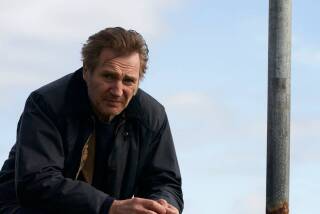Donegal Weaves a Poetic Spell of Enchantment : The region’s lonely roads, magnificent mountains, meadows and peat bogs are the essence of Ireland.
- Share via
DONEGAL, Ireland — “Handwoven in my cottage in Donegal. K. Boyle, Weaver,” says the stitched label on the incredibly soft tweed mufflers we purchased here for a pittance. But it is the colors that best “Weave the spell of Donegal . . . brown of earth and moorland, gray of drifting turf smoke, white of hawthorne spray, rust of autumn leaves and gold of gorse and wheaten sheaves.” Even leaving out the purple heather, the Irish have always had a way with words.
Doyle is one of the 30 or 40 hand-weavers still working at old wooden looms in this northernmost of Irish counties, as they have for centuries. Their wives and daughters card and spin the wool, helping turn out about 135 yards of the precious cloth in a week.
For the record:
12:00 a.m. March 22, 1992 For the Record
Los Angeles Times Sunday March 22, 1992 Home Edition Travel Part L Page 2 Column 1 Travel Desk 2 inches; 51 words Type of Material: Correction
Travel to Ireland--Due to a reporting error, a story on Donegal, Ireland, in last week’s Travel section stated incorrectly that British Airways flies from Los Angeles to Dublin. Also, because of an error by a Delta Airlines reservations agent, the price of a round-trip flight from LAX to Dublin was listed as $598. Until the end of March, the fare is actually $798.
Donegal’s mountains and headlands reach out like fingers into the wild North Atlantic, creating majestic bays and loughs around the crescent coast. The region, along with neighboring Sligo County, is scattered with Europe’s oldest and largest collection of megalithic remains. Alas, the weather can take one completely unawares, changing from cloud-fleeced sky to the chill wet lash of a morning storm with all the shiftiness of a legendary leprechaun.
Donegal’s coast is one of the loneliest in Europe, speckled with tiny fishing villages and remote hamlets with thatch-roof houses, each often having but one small hotel or perhaps a bed and breakfast inn. The hinterlands are scarcely more populous, leaving Donegal Town with a population of 2,000, the only place one could rightfully call anything but a village. And Gaelic is still the language of choice in the northwest part of the county.
Yet Donegal (Don-a-GAL), a wild region of magnificent mountains, meadows and peat bogs that has been inhabited for at least seven millennia, is the essence of Ireland. Anyone seeking beauty, grandeur and quietude will find immense pleasure in driving the lonely roads of Donegal’s highlands and peninsulas, roads that always seem to lead to a warm hearth and even warmer Irish welcome.
How long/how much? After landing at Sligo city, take at least three full days to drive around Donegal. We found lodging and dining prices from moderate on up, almost an anomaly in today’s Europe, where most countries are “up.”
Getting settled in: Planning a trip through Donegal could very well land one in these places. Hotel Carrig Rua on the main road in the coastal village of Dunfanaghy on Sheephaven Bay resembles an old-style coaching stop. Many of the hotel’s 22 bedrooms overlook the sea. The bedrooms are very comfortable, cozy and in good taste. The Red Rock dining room does an excellent job with steaks and seafood. Dunfanaghy has an 18-hole golf course and miles of fine beaches.
The Redcastle Country Hotel in Moville on the western shore of Lough Foyle is really a mini-resort, with its own golf course, tennis courts, inside and outside heated pools and fitness center. All bedrooms are handsomely furnished with pastel fabrics, some with four-posters, and the hotel is right on the golf course with no green fees for guests. Another fine dining room here; particularly tasty are the sumptuous desserts.
Strand Hotel in Ballyliffen on the north coast’s Inishowen Peninsula is very contemporary in style, yet the personal touch of owners Brian and Anne Harkin gives it a homey atmosphere. The dining room overlooks the beautiful shoreline, and the small lounge bar is cheerful indeed. Each of the bedrooms has TV, a hair dryer and coffee- and tea-making gear.
Markree Castle, nine miles from the Sligo Airport in Collooney, has been in the Cooper family since 1640, with William Butler Yeats and other luminaries as regular visitors. The castle’s magnificent oak staircase is overlooked by a stained-glass window tracing the family back to England’s King John.
Huge bedrooms, while simply decorated, all have spectacular views of the 1,000-acre estate. There are five golf courses in the area, and a riding school nearby. More about the dining room later.
Regional food and drink: Seafood (salmon, whiting, mackerel, cod, plaice, trout, prawn and oysters) is here in grateful abundance. And the Irish, like the Scots, know more about making breads than the English apparently will ever learn, particularly the glorious Irish soda bread and scones. They also do marvelous things with duck, venison and other game.
Good wines are rather scarce, but remember that “Guinness is good for you,” Harp lager is excellent and Smithwick ale comes straight from the wood.
Good regional dining: Lurgyvale Thatched Cottage, a 150-year-old farmer’s home near Letterkenny on the Dunfanaghy road, shouldn’t be missed by anyone interested in Donegal life in the mid-19th Century. This is a place for a light lunch or tea with homemade scones and brown bread lavished with homemade gooseberry and currant jams. Everything is prepared at the cottage’s open hearth over a turf fire, then served at rustic tables. All the scones, bread, tea or coffee one can down keeps coming for $2.50. Then tour the cottage’s charming period bedrooms and the farmyard with its old implements.
Markree Castle’s splendid dining salon of gilt cherubs and magnificent chandeliers serves a four-course dinner menu of smoked salmon with horseradish cream, consomme with stuffed pastry shells, roast duckling with vegetables and salad, dessert and tea or coffee. The cost is $28, and many say the castle’s chef is the county’s best.
Sweeny’s White Horse Bar, halfway along the Sligo-Donegal Town road at Ballyshannon, does great pub grub. There’s a 200-year-old cellar, once the hangout of smugglers, plus a typical Irish bar lined with regulars, peat fires in all the hearths and deep couches around the fireplaces. We had a sturdy wild mushroom soup for $1.25, house-made pate with salad ($2.75) and a large platter of smoked salmon for the same. John and Pat Sweeny are the typical Irish pub hosts, eager for all to leave happy and well-fed.
On your own: Anyone interested in Ireland’s early troubles with England must surely visit the Heritage Centre in Rathmullen. During Queen Elizabeth I’s reign, by 1601 most of Ireland was turned over to English “planters” and Protestantism--only the far north holding out, with its poets, brehons (storytellers) and chroniclers still free to roam about with the news.
After a series of defeats, the Flight of the Earls (major chieftains) to Spain left Rathmullen in 1607, bent on mustering support for their cause. A few remaining minor chieftains still defied the crown futilely, but by 1609, the Gaelic system of feudalism was replaced by English laws and landlords in all of Ireland. A captivating and informative exhibition of the life and times of the Earls is on display at a massive fortress on Rathmullen’s harbor.
Anyone in search of less weighty pursuits should ask if there’s an evening of Irish music at any of the nearby pubs, and there usually is. We chanced upon a marvelous night of music and songs at Ruari’s House in Gortahork on the coast. Nothing staged here, just eight spirited locals belting out the likes of “Welcome Poor Paddy Home” and other lively traditional Irish jigs. Tables were packed and animated, suds free-flowing.
It’s a tossup whether the more breathtaking scenery is at Malin Head at the northernmost tip of Ireland, or Glenveagh National Park at the north end of Lough Veagh. The latter has a lovely castle and gardens, plus the largest herd of red deer in Ireland, and lots of birds and wildflowers.
Those Donegal tweeds, the only ones still hand-woven in the county and sold throughout the world, may be found at the Magee factory shop on The Triangle (town center) in Donegal Town.
And try to plan a stop at Drumcliff, five miles north of Sligo on the Donegal road. Yeats is buried in the lovely old churchyard beneath a simple limestone slab inscribed with his words: “Cast a cold eye on life, on death, Horsemen pass by.”
GUIDEBOOK
Donegal Diversions
Getting there: Fly Delta or British Airways to Dublin, then Air Lingus on to Sligo. An advance-purchase, round-trip flight from Los Angeles to Dublin is $598; $115 to Sligo and return on Aer Lingus. It’s 41 miles from Sligo to Donegal, and a rental car is the best bet for seeing the countryside.
A few fast facts: The Irish pound recently sold for $1.69, making our dollar worth about 59 cents. Best time for visits is between late spring and fall. Otherwise, it’s wet going much of the year.
Where to stay: Carrig Rua Hotel ($79 double, B&B;); Redcastle Country Hotel ($102 double, B&B;); Strand Hotel ($77 double, B&B;); Markree Castle ($143 double, B&B;). All breakfasts are the very ample, full Irish version, and all hotels have special weekend and/or three-day rates with meals.
For more information: Call the Irish Tourist Board at (212) 418-0800, or write (757 3rd Ave., 19th Floor, New York 10017) for a 32-page color magazine on all the regions of Ireland, including the Donegal coast and Highlands, plus map, lists of accommodations by counties, culture, sights and other travel information.
More to Read
Sign up for The Wild
We’ll help you find the best places to hike, bike and run, as well as the perfect silent spots for meditation and yoga.
You may occasionally receive promotional content from the Los Angeles Times.






